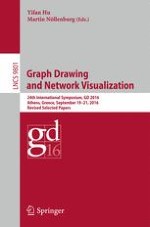This book constitutes revised selected papers from the 24th International Symposium on Graph Drawing and Network Visualization, GD 2016, held in Athens, Greece, in September 2016.
The 45 papers presented in this volume were carefully reviewed and selected from 99 submissions. They were organized in topical sections named: large graphs and clutter avoidance; clustered graphs; planar graphs, layered and tree drawings; visibility representations; beyond planarity; crossing minimization and crossing numbers; topological graph theory; special graph embeddings; dynamic graphs, contest report.
